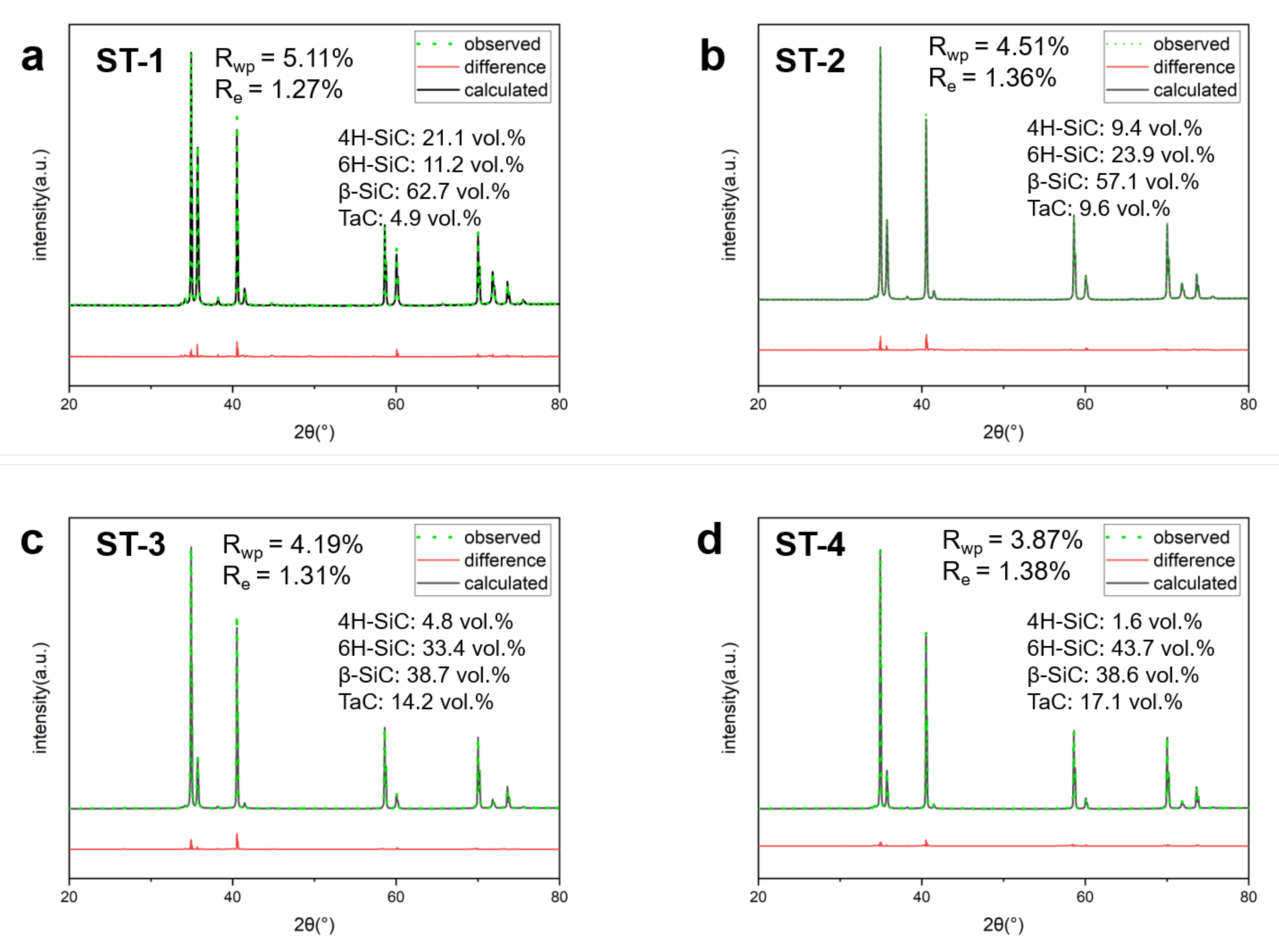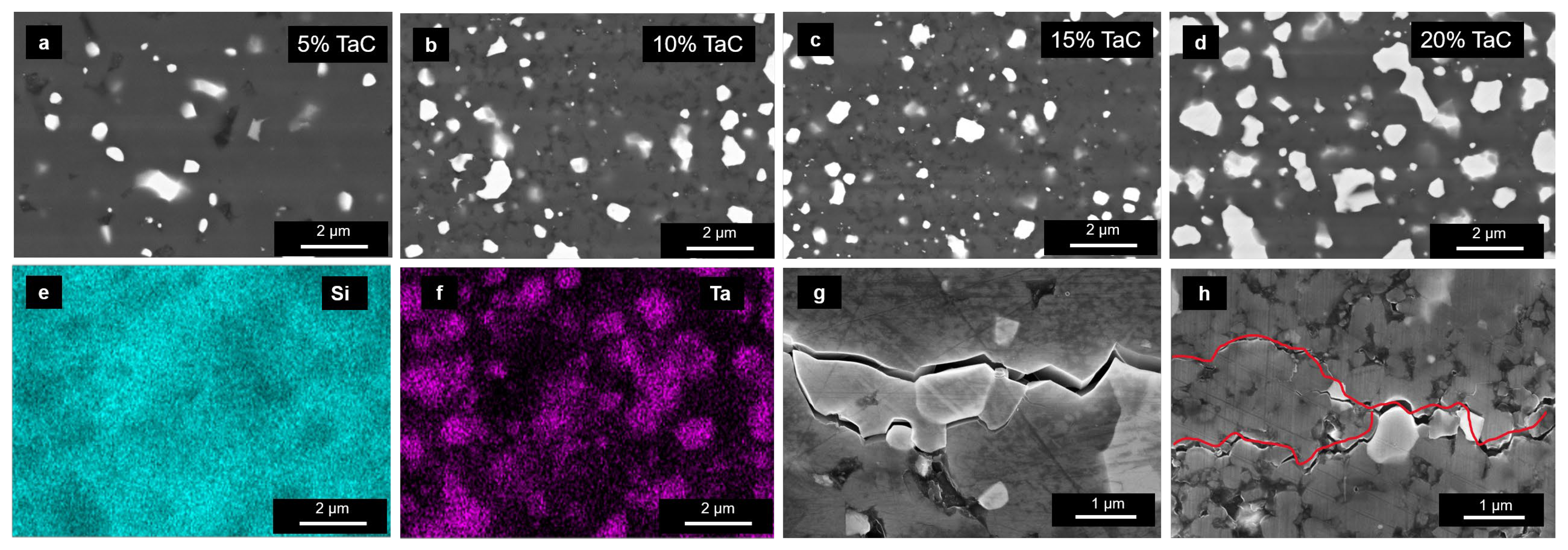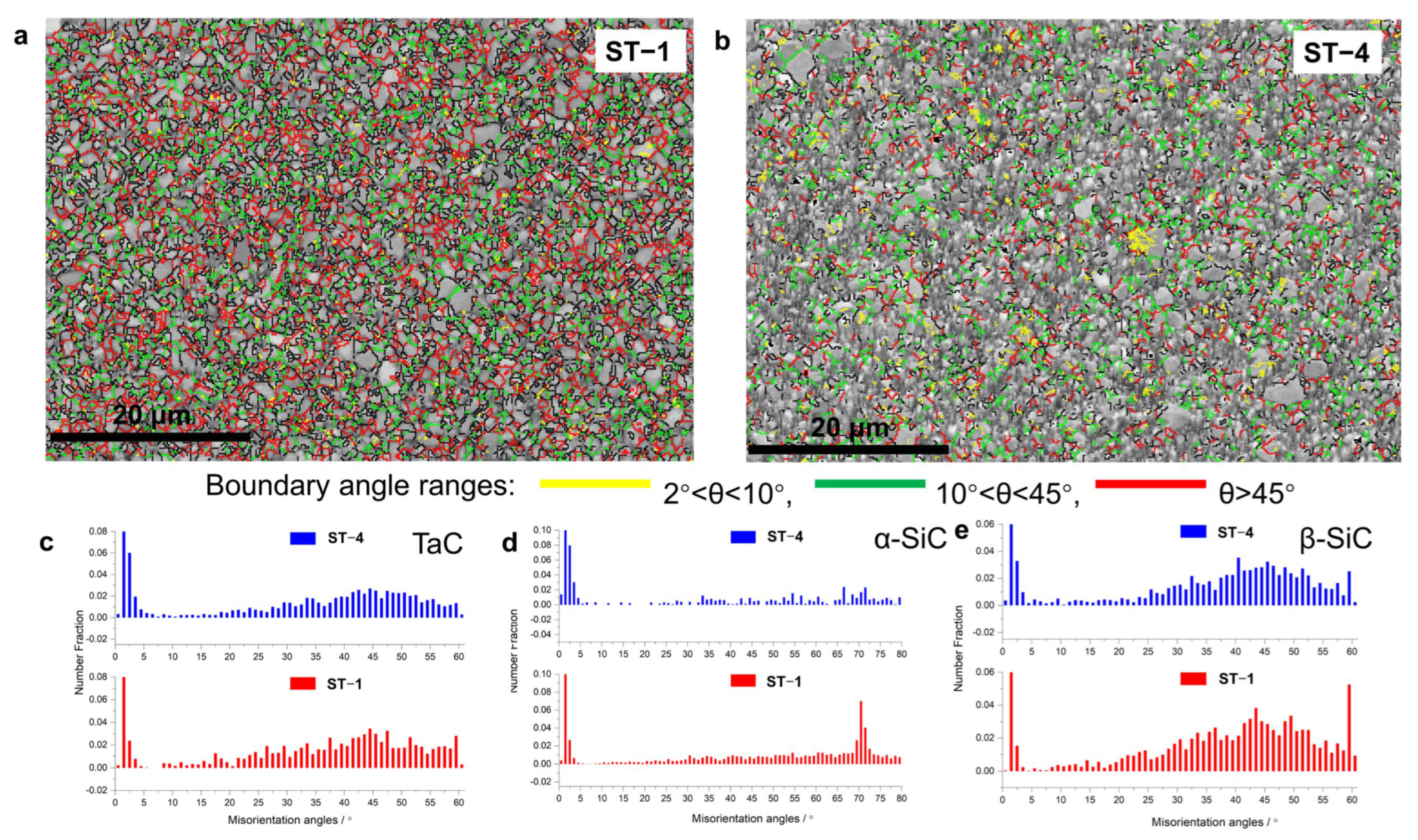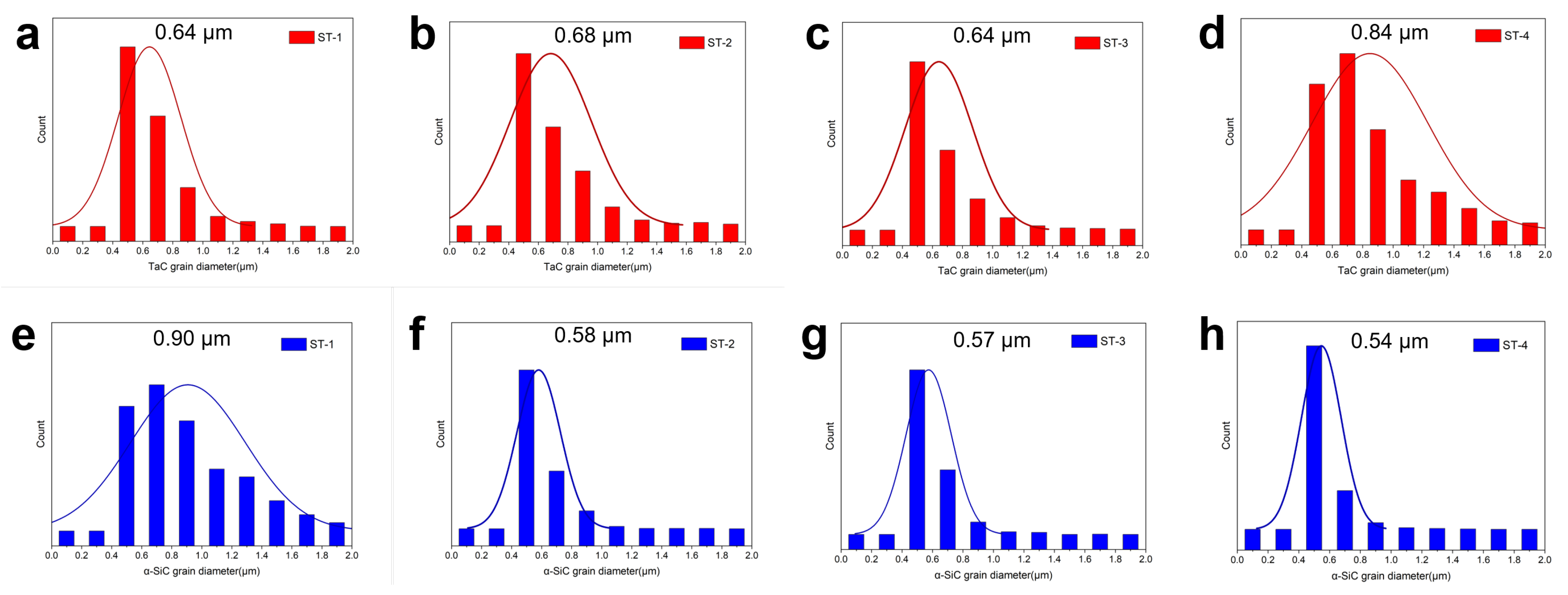β→α Phase Transformation and Properties of Solid-State-Sintered SiC Ceramics with TaC Addition
Abstract
:1. Introduction
2. Materials and Methods
- KIC—fracture toughness (MPa·m1/2);
- P—load (N);
- L—span (mm);
- b—width (mm);
- a—notch depth (mm);
- W—height (mm).
3. Results and Discussion
4. Conclusions
Author Contributions
Funding
Institutional Review Board Statement
Informed Consent Statement
Data Availability Statement
Conflicts of Interest
References
- Huang, Z.; Liu, G.; Liu, X.; Chen, Z.; Jiang, D. Manufacture of large-scale lightweight SiC mirror for space. In Proceedings of the 2012 International Workshop on Image Processing and Optical Engineering, Harbin, China, 9–10 January 2012; Guo, H., Ding, Q., Eds.; SPIE: Washington, DC, USA, 2011; p. 83351R. [Google Scholar] [CrossRef]
- Cramer, C.L.; Elliott, A.M.; Lara-Curzio, E.; Flores-Betancourt, A.; Lance, M.J.; Han, L.; Blacker, J.; Trofimov, A.A.; Wang, H.; Cakmak, E.; et al. Properties of SiC-Si made via binder jet 3D printing of SiC powder, carbon addition, and silicon melt infiltration. J. Am. Ceram. Soc. 2021, 104, 5467–5478. [Google Scholar] [CrossRef]
- Xu, J.; Zhou, X.; Zou, S.; Chen, L.; Tatarko, P.; Dai, J.Q.; Huang, Z.; Huang, Q. Low-temperature Pr3Si2C2-assisted liquid-phase sintering of SiC with improved thermal conductivity. J. Am. Ceram. Soc. 2022, 105, 5576–5584. [Google Scholar] [CrossRef]
- Malik, R.; Kim, Y. Effect of AlN addition on the electrical resistivity of pressureless sintered SiC ceramics with B4C and C. J. Am. Ceram. Soc. 2021, 104, 6086–6091. [Google Scholar] [CrossRef]
- Ni, D.; Cheng, Y.; Zhang, J.; Liu, J.-X.; Zou, J.; Chen, B.; Wu, H.; Li, H.; Dong, S.; Han, J.; et al. Advances in ultra-high temperature ceramics, composites, and coatings. J. Adv. Ceram. 2021, 11, 1–56. [Google Scholar] [CrossRef]
- He, R.; Zhou, N.; Zhang, K.; Zhang, X.; Zhang, L.; Wang, W.; Fang, D. Progress and challenges towards additive manufacturing of SiC ceramic. J. Adv. Ceram. 2021, 10, 637–674. [Google Scholar] [CrossRef]
- Song, C.; Ye, F.; Cheng, L.; Liu, Y.; Zhang, Q. Long-term ceramic matrix composite for aeroengine. J. Adv. Ceram. 2022, 11, 1343–1374. [Google Scholar] [CrossRef]
- Lee, K.N.; Harder, B.J.; Puleo, B.J.; Almansour, A.S.; Kiser, J.D.; Setlock, J.A.; Fox, D.S.; Cuy, M.D.; Kalluri, S.; Bhatt, R.T. Manufacturing Process Development and Rig Validation of Slurry Environmental Barrier Coatings for SiC Ceramic and SiC Composite Sub-Components. Coatings 2022, 12, 1635. [Google Scholar] [CrossRef]
- Hong, Y.; Xie, F.; Xiong, L.; Yu, M.; Cheng, X.; Qi, M.; Shen, Z.; Wu, G.; Ma, T.; Jiang, N. The Ballistic Performance of Laminated SiC Ceramics for Body Armor and the Effect of Layer Structure on It. Appl. Sci. 2021, 11, 6145. [Google Scholar] [CrossRef]
- Hong, J.; Hon, M.; Davis, R. Self-diffusion in alpha and beta silicon carbide. Ceramurg. Int. 1979, 5, 155–160. [Google Scholar] [CrossRef]
- Andreev, P.; Drozhilkin, P.; Alekseeva, L.; Smetanina, K.; Rostokina, E.; Balabanov, S.; Boldin, M.; Murashov, A.; Shcherbak, G. Spark Plasma Sintering of Si3N4 Ceramics with Y2O3–Al2O3 (3–10% wt.) as Sintering Additive. Coatings 2023, 13, 240. [Google Scholar] [CrossRef]
- Guo, S.; Zhu, F.; Xiu, Z.; Zhang, M.; Sun, X. Enhanced Performance in Si3N4 Ceramics Cutting Tool Materials by Tailoring of Phase Composition and Hot-Pressing Temperature. Coatings 2023, 13, 475. [Google Scholar] [CrossRef]
- Liang, H.; Yao, X.; Huang, Z.; Zeng, Y.; Su, B. Effect of sintering techniques on the microstructure of liquid-phase-sintered SiC ceramics. J. Eur. Ceram. Soc. 2016, 36, 1863–1871. [Google Scholar] [CrossRef]
- Liang, H.; Yao, X.; Zhang, J.; Liu, X.; Huang, Z. Low temperature pressureless sintering of α-SiC with Al2O3 and CeO2 as additives. J. Eur. Ceram. Soc. 2014, 34, 831–835. [Google Scholar] [CrossRef]
- Yi, J.; Xue, W.J.; Xie, Z.P.; Liu, W.; Cheng, L.X.; Chen, J.; Wang, L.; Cheng, H.; Gao, Y.X.; Wang, H.B. The dependence of interlocking and laminated microstructure on toughness and hardness of β-SiC ceramics sintered at low temperature. Mater. Sci. Eng. A 2013, 586, 338–341. [Google Scholar] [CrossRef]
- Izhevskyi, V.A.; Bressiani, A.H.A.; Bressiani, J.C. Effect of Liquid Phase Sintering on Microstructure and Mechanical Properties of Yb2O3-AlN Containing SiC-Based Ceramics. J. Am. Ceram. Soc. 2005, 88, 1115–1121. [Google Scholar] [CrossRef]
- Biswas, K. Solid State Sintering of SiC-Ceramics. MSF 2009, 624, 71–89. [Google Scholar] [CrossRef]
- Magnani, G.; Sico, G.; Brentari, A.; Fabbri, P. Solid-state pressureless sintering of silicon carbide below 2000 °C. J. Eur. Ceram. Soc. 2014, 34, 4095–4098. [Google Scholar] [CrossRef]
- Wu, H.; Li, Y.; Yan, Y.; Yin, J.; Liu, X.; Huang, Z.; Lee, S.-H.; Jiang, D. Processing, microstructures and mechanical properties of aqueous gelcasted and solid-state-sintered porous SiC ceramics. J. Eur. Ceram. Soc. 2014, 34, 3469–3478. [Google Scholar] [CrossRef]
- Zhang, J.; Jiang, D.; Lin, Q.; Chen, Z.; Huang, Z. Properties of silicon carbide ceramics from gelcasting and pressureless sintering. Mater. Des. 2015, 65, 12–16. [Google Scholar] [CrossRef]
- Su, B.; Liu, G.; Huang, Z.; Liang, H.; Liu, X.; Chen, Z. The effect of in situ synthesized AlN on densification of SiC ceramics by pressureless sintering. Ceram. Int. 2015, 41, 14172–14178. [Google Scholar] [CrossRef]
- Chen, J.; Chen, J.; Yao, X.; Chen, Z.; Liu, X.; Huang, Z. Effect of sintering temperature on electrical properties of SiC/ZrB2 ceramics. J. Eur. Ceram. Soc. 2018, 38, 3083–3088. [Google Scholar] [CrossRef]
- Li, Y.; Wu, H.; Kim, H.N.; Liu, X.; Huang, Z. Simultaneously enhanced toughness and strain tolerance of SiC-based ceramic composite by in-situ formation of VB2 particles. J. Eur. Ceram. Soc. 2017, 37, 399–405. [Google Scholar] [CrossRef]
- Huang, Y.; Jiang, D.; Zhang, X.; Liao, Z.; Huang, Z. Enhancing toughness and strength of SiC ceramics with reduced graphene oxide by HP sintering. J. Eur. Ceram. Soc. 2018, 38, 4329–4337. [Google Scholar] [CrossRef]
- Sedlák, R.; KovalĿíková, A.; Girman, V.; Múdra, E.; Rutkowski, P.; Dubiel, A.; Dusza, J. Fracture characteristics of SiC/graphene platelet composites. J. Eur. Ceram. Soc. 2017, 37, 4307–4314. [Google Scholar] [CrossRef]
- Vorotilo, S.; Patsera, E.; Shvindina, N.; Rupasov, S.; Levashov, E. Effect of In Situ Grown SiC Nanowires on the Pressureless Sintering of Heterophase Ceramics TaSi2-TaC-SiC. Materials 2020, 13, 3394. [Google Scholar] [CrossRef]
- Hu, J.; Luo, G.; Zhang, J.; Sun, Y.; Shen, Q.; Zhang, L. Sintering Mechanism and Microstructure of TaC/SiC Composites Consolidated by plasma-activated sintering. Ceram. Int. 2019, 46, 2624–2629. [Google Scholar] [CrossRef]
- Sharma, S.K.; Chaudhary, K.; Gupta, Y.; Kalin, M.; Kumar, B.V.M. Erosive wear behavior of spark plasma-sintered SiC–TaC composites. Int. J. Appl. Ceram. Technol. 2022, 19, 1691–1701. [Google Scholar] [CrossRef]
- Nader, M.; Aldinger, F.; Hoffmann, M.J. Influence of the α/β-SiC phase transformation on microstructural development and mechanical properties of liquid phase sintered silicon carbide. J. Mater. Sci. 1999, 34, 1197–1204. [Google Scholar] [CrossRef]
- Liu, L.; Feng, Y.; Zhang, Z.; Yu, Z. Microstructure and mechanical properties of the spark plasma sintered TaC/SiC composites. Mater. Sci. Eng. A. 2011, 529, 479–484. [Google Scholar] [CrossRef]
- Zhang, B.; Yin, J.; Huang, Y.; Chen, J.; Liu, X.; Huang, Z. Harmonized toughening and strengthening in pressurelessly reactive-sintered Ta0.8Hf0.2C-SiC composite. J. Eur. Ceram. Soc. 2018, 38, 5610–5614. [Google Scholar] [CrossRef]
- Grasso, S.; Saunders, T.; Porwal, H.; Milsom, B.; Tudball, A.; Reece, M. Flash Spark Plasma Sintering (FSPS) of α and β SiC. J. Am. Ceram. Soc. 2016, 99, 1534–1543. [Google Scholar] [CrossRef]
- Ortiz, A.L.; Bhatia, T.; Padture, N.P.; Pezzotti, G. Microstructural Evolution in Liquid-Phase-Sintered SiC: Part III, Effect of Nitrogen-Gas Sintering Atmosphere. J. Am. Ceram. Soc. 2004, 85, 1835–1840. [Google Scholar] [CrossRef]
- Shao, Q.Q.; Gu, H. Transition-layer of core–rim structures and β→α transformation in SiC ceramics. J. Mater. 2023, 9, 299–309. [Google Scholar] [CrossRef]
- Zangvil, A.; Ruh, R. Phase Relationships in the Silicon Carbide-Aluminum Nitride System. J. Am. Ceram. Soc. 1988, 71, 884–890. [Google Scholar] [CrossRef]




| Specimen | Composition | Apparent Density (g/cm3) | Relative Density (%) | Bending Strength (MPa) | Elastic Modulus (GPa) | Fracture Toughness (MPa·m1/2) | Vickers Hardness (GPa) |
|---|---|---|---|---|---|---|---|
| ST-1 | 95% β-SiC + 5%TaC | 3.45 | 91.2 | 455.5 ± 52.5 | 293.8 ± 12.5 | 4.5 ± 0.8 | 15.6 ± 0.1 |
| ST-2 | 90% β-SiC + 10%TaC | 4.02 | 92.4 | 485.1 ± 82.7 | 296.0 ± 15.7 | 6.0 ± 1.0 | 13.9 ± 0.1 |
| ST-3 | 85% β-SiC + 15%TaC | 4.69 | 95.6 | 516.4 ± 47.0 | 315.8 ± 19.3 | 6.9 ± 0.5 | 14.0 ± 0.2 |
| ST-4 | 80% β-SiC + 20%TaC | 5.37 | 98.0 | 708.8 ± 28.7 | 384.9 ± 28.3 | 8.3 ± 0.8 | 17.5 ± 0.4 |
Disclaimer/Publisher’s Note: The statements, opinions and data contained in all publications are solely those of the individual author(s) and contributor(s) and not of MDPI and/or the editor(s). MDPI and/or the editor(s) disclaim responsibility for any injury to people or property resulting from any ideas, methods, instructions or products referred to in the content. |
© 2023 by the authors. Licensee MDPI, Basel, Switzerland. This article is an open access article distributed under the terms and conditions of the Creative Commons Attribution (CC BY) license (https://creativecommons.org/licenses/by/4.0/).
Share and Cite
Zheng, S.; Zhang, B.; Liu, X.; Chen, Z.; Huang, Z.; Yin, J. β→α Phase Transformation and Properties of Solid-State-Sintered SiC Ceramics with TaC Addition. Materials 2023, 16, 3787. https://doi.org/10.3390/ma16103787
Zheng S, Zhang B, Liu X, Chen Z, Huang Z, Yin J. β→α Phase Transformation and Properties of Solid-State-Sintered SiC Ceramics with TaC Addition. Materials. 2023; 16(10):3787. https://doi.org/10.3390/ma16103787
Chicago/Turabian StyleZheng, Shiyi, Buhao Zhang, Xuejian Liu, Zhongming Chen, Zhengren Huang, and Jie Yin. 2023. "β→α Phase Transformation and Properties of Solid-State-Sintered SiC Ceramics with TaC Addition" Materials 16, no. 10: 3787. https://doi.org/10.3390/ma16103787





